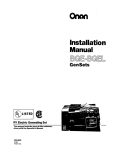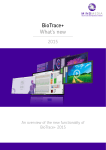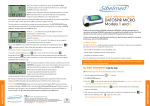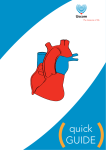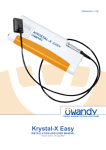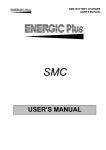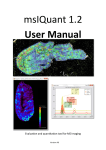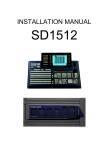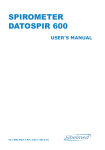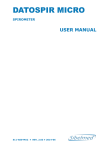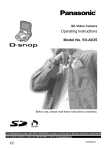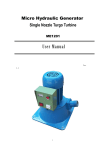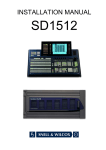Download SPIROMETER DATOSPIR - 120 511-890
Transcript
" Annex SpO2"
SPIROMETER
D A T O S P I R - 120
511-890-MU2
*USER'S MANUAL*
2012-11 • Rev.: 2.02
SPIROMETER DATOSPIR-120
USER MANUAL "Annex SpO2 "
E. 2.02
1.
INSTRUCTIONS FOR USE AND INSTALLATION
1.1.
1.2.
1.3.
1.4.
1.5.
INTRODUCTION
PULSE OXYMETRY PROGRAM
PULSE OXYMETRY SETUP
PULSE OXYMETRY TEST PROCEDURE
1.4.1.
INPUT OF TEST DATA
1.4.2.
PERFORMANCE OF PULSE OXYMETRY TESTS
1.4.3.
SETUP
1.4.4.
TRENDS DISPLAY
1.4.5.
PRINTING AND/OR SAVING IN THE DATA BASE
1.4.6.
TEST TRANSFERENCE
PULSE OXYMETRY MEASURES DURING SPIROMETRIC TESTS
2.
TECHNICAL SPECIFICATIONS
3.
FUNCTIONING BASIS
4.
CLEANING
5.
MODIFICATIONS
SAFETY
INDICATIONS FOR USE
This oximetry sensor should be used by a physician or under the supervision of
medical staff.
The pulse oximeter does NOT require calibration.
The pulse oximeter has NO physiological WARNINGS.
Pulse oximeter probes do NOT allow temporary immersion.
The pulse oximeter waveform is NOT normalizzed.
Patient movements or excessive lighting can affect the accuracy of the device.
The pulse oximetry module has CE marking and can not reach temperatures> 42 º.
The oxygen saturation and heart rate measures must be performed using the
sensors manufactured by MEDIAID: POX 050-105S (clip) and POX050-820s
(Flexible), which have been validated clinically. Otherwise, there may be significant
measurement errors.
These pulse oximetry probes have been validated for the M15 module from
MEDIAID.
The wavelengths used are 660 nm (red) and 910 nm (infrared) and the optical
power is about 9.6mW.
Consult the instructions for use of the probes, before use. Follow strictly
manufacturer's safety instructions, as well as those specified in this manual.
See instructions for use of the sensor to evaluate the toxicity of SpO2 sensor.
The maximum recommended application’s time of an oximeter, in the same place,
is 8 hours. The point of placement must be reviewed frequently to determine the
position, the movement and the skin sensitivity of the patient. The reaction to the
sensors by the patients may be different depending on their health and skin
conditions. No adhesive material should be used if the patient has an allergic
reaction to it.
For log term monitoring, is recommended to use flexible or disposable sensors.
The adult sensor is intended for use on people over 12 years old. The peadiatric
probe is for children between 3 and 12 years. Although, the adults probes can be
used on any pediatric patient whose fingertip reaches the finger stop of the sensor
and on whom the sensor fits securely.
The system can measure pulse and functional oxygen saturation. A functional
meter can not be used to evaluate the accuracy of pulse oximeter probe or a pulse
oximeter monitor.
DEGREE OF PROTECTION AGAINST LIQUIDS
Degree of protection against harmful ingress of water. Drip-proof IPX1
RISKS OF CONTAMINATION
Although unlikely, the organisms can be transmitted by pulse oximetry. Therefore,
the pulse oximeter finger clip should be cleaned after each patient use by either
soapy water or the disinfectant solution specified by the manufacturer.
RISK OF INTERFERENCE
Avoid interference such as electromagnetic disturbances, stroke, abnormal
hemoglobin, intravascular contrast, states of low perfusion and skin pigmentation
can affect the operation pulse oximeter.
RISKS FOF EXPLOSION
DO NOT use the equipment in the presence of flammable anesthetics or gases.
THAT MAY CAUSE EXPLOSION.
REMOVAL OF WASTE FROM ELECTRICAL AND ELECTRONIC APPLIANCES
BY DOMESTIC USERS IN THE EUROPEAN UNION
The product must be recycled as the WEEE directive. (For more information,
consult the user’s manual of DATOSPIR -110/120).
1. INSTRUCTIONS FOR USE AND INSTALLATION
1.1.
INTRODUCTION
This manual is an annex to the user's manual of the Spirometer DATOSPIR-120, for
the pulse oxymetry functioning. For consults and observations referred to the device
go to chapter 1 of the general manual.
With the Pulse oxymetry option , the DATOSPIR-120 can perform individual measures
of the Oxigen Saturation (SpO2 ) and of the Pulse Rate (PR), or long duration
studies for the control of patients during sleep or any other situation (desaturations
measure, etc...).
In case of long duration studies, we will be able to display the Trends afterwards .By
trends we mean the evolution of signals SPO2 and PR versus time.
It will also be possible to calculate the parameters associated to the trends, print
them and save them in the data base.
1.2. PULSE OXYMETRY PROGRAM
Next the options of the pulse oxymetry program are shown:
Test Data
Patient
Code
Name and surname
Age, height, weight and sex
Setup
WARNING Thresholds
Acoustic WARNINGS
SpO Averaging
Enable/Disable Acoustic WARNING
Trends Recording
Trends Display
Setup
Forwarding and Backwarding the signal
Test Parameters
Parameters Printing
Saving parameters in the Data Base
1.3. PULSEOXIMETRY SETUP
The SpO2 module is an option included in the DATOSPIR-120. It is advisable for any
user to set it up according to his needs.
To enter the Pulse oxymetry setup menu, press the key F2 in the main menu, and then
F7.
F1
F3
F5 y F6
ESC, exit from this screen and goes back to the previous one.
Deletes the selected value
Takes the cursor back to the previous field or advances it to the
next
F7
Validates the entered data and goes to the next screen.
This screen enables to configurate the different parameters of the pulse oxymetry:
- Maximum and minimum values of SpO2 (30-100 %) and PR (20-250 BPM)
WARNINGS
- Average of SpO (between 4 and 16 samples). The Average of PR is fixed
(10 samples)
- Superior and inferior level for display of trends of SpO and PR.
- Value of the reference line for both channels.
- Time of record on screen (between 5s and 29m 59s).
It is also possible to setup quickly and directly these values from inside the pulse
oxymetry or trends screen.
1.4. PULSE OXYMETRY TEST PROCEDURE
WARNING
Use only the oximetry sensor supplied by the DATOSPIR 110/120 spirometer
manufacturer. If you use non-validated sensors with this equipment, that may
cause significant measurement errors.
1 Plug the pulse oximetry sensor supplied into the no.8 jack on the device.
WARNINGS
Do not twist unnecessary or use excessive force when using, connecting,
disconnecting or storing the finger sensor.
Misuse or improper handling of the sensors may cause damage to the sensor or
to the cable. This would cause incorrect measurements and readings.
2 Select a suitable site for the sensor. The first finger (index) is the preferred
location. Alternative sites recommended are the thumb, little finger or the large
toe.
3 Insert the finger right to the end of the sensor to get accurate measurements.
The fingernail must be kept pointing toward the upper part of the sensor and the
cable must be positioned along the top of the hand (or food).
WARNING
Ensure that long fingernails do not interfere with the proper positioning of the
finger or with sensor function. Remove nail polish or artificial acrylic nails before
placying the SpO2 sensor, as this can cause incorrect readings.
4 To obtain the best results, especially during long-term studies (8 hours approx.),
fasten the cable separately from the sensor, using surgical tape; preferably
around the base of the finger (see the figure above). Make sure that the tape
fastening the cable does not restrict blood circulation.
WARNING
For log term monitoring, is recommended to use flexible or disposable sensors.
1.4.1. INPUT OF TEST DATA
When entering the Pulse oxymetry Program, the first thing to do is enter the test
data.
See paragraph 1.8.1 of the general manual , for the data input.
If the memory has a saved test, the program will go directly to the next screen
(paragraph 1.4.2).
1.4.2. PERFORMING PULSE OXYIMETER TESTS
When entering this screen, the pulse oxymeter starts automatically to take samples; the
values of Oxigen Saturation (SpO
) and Pulse Rate (PR) are showed together the
2
peripherical pulse wave. The duration of the wave showed on the screen is 5 seconds.
The maximum and minimum WARNING values for SpO and PR are also
displayed
respectively on screen. If the value for an WARNING is surpassed, an intermittent
warning is displayed in the bottom part of the screen. If the Acoustic WARNING is
activated, a sound will be heard.
In the upper part of the screen the time of signal (trends) saved in the memory up to
that moment is indicated.
F1
ESC, exit form this screen and go back to the previous one.
F2
Setup the WARNINGS and the Averaging (See Paragraph
1.4.3) F3 Enables or Disables the acoustic warning in case of
WARNING. F4 Enables to modify the test data.
F5
Starts or stops the record of a study.
F6
Enters the Trends Menu (See Paragraph 1.4.4)
F8
Deletes the study in memory.
WARNING
When the quality of the signal is low or the finger is not present, the SpO2 values
are set to zero to avoid showing incorrect values.
The device does not lost patient data if it is turned off.
The SpO2 data are updated every second, the value of SpO2 and pulse rate is
directly provided by the module.
A) INSTANT TESTS
In the instant pulse oxymetry measures, the screen indicates the values for SpO2
and PR according to the setup average.
If you need to print the results, you must record previously the signal (by pressing the
key F5 of start) during the desired time and then follow the instructions detailed in
Paragraphs1.4.4 and 1.4.5.
B) LONG DURATION TESTS
In long duration tests, press F5 to start the recording. An intermittent message
("RECORDING") in the central part of the screen indicates that the study is being
recorded.
When more than 5 minutes recording the signal without pressing any key, the Display
light is switched off automatically, to avoid dirturbing the patient in a long duration
study. When pressing any key, the light is switched on again.
It is important to point out that the signal in memory is related to the patient code
entered. If you start and stops the study without changing the patient code or
without deleting the study, fragments of signal one after one will be saved up to
8 hours. The device understands that all the fragments correspond to the same
patient and the calculation of parameters is made for the total memory.
El equipo interpretará que todos los fragmentos corresponden a un mismo paciente
y el cálculo de los parámetros lo realizará sobre el total de la memoria.
To perform the test to other patient, delete the test (pressing F8) and change the
patient data (pressing F4).
To display the saved signal and calculate the parameters, enter the trends screen
through the key F6.
If the dedal disconnects, the signals SpO2 and PR will be presented with value 0.
These periods of time will not be taken into account for calculating the parameters
and test duration.
1.4.3. SETUP
During the acquisition of oxymetry and pulse wave signals, it is possible to enter the
setup menu to modify some of the data displayed on the screen.
It is possible to modify the maximum and minimum SpO2 and PR WARNING
thresholds..
The acoustic signal of the WARNING and of the "beep" (signal coinciding with each
pulse), can be enabled o disabled.
The averaged value of SpO2 can be changed between 4 and 16 samples. The lower
the selected averaged value is, the quicker the response will be, but also more
sensitive to artefacts. On the contrary, if the selected averaged value is higher, the
measure is more stable and the response will be slower.
For a instant measure, it is advisable a high averaged value. On the contrary for a
desaturation study, a low value is better.
1.4.4. TRENDS DISPLAY
Only if a study has been recorded, it will be possible to enter the trends menu.
F1
F2
F4 y F8
F5
F6
F7
ESC, exit from this screen and goes bact to the previous one.
Setups the Trends screen.
Goes backwards or goes forwards a page.
Enables to go to a specific page (signal fragment).
It moves to Search Mode.
Calculates and displays the parameters values.
The screen displays the signal fragment of
SpO2
time of screen .
and PR according to the selected
In the upper left part, the time related to the start of the study is displayed (hh:mm:ss).
Each channel shows a discontinuous line of reference to be selected by the user in
the setup. This line is useful when verifying if the samples surpasse a certain value.
The key F2, enters the trends setup screen.
The key F5 enables the selection fo the desired signal fragment.
By pressing the key F6, we enter the SEARCH mode. Pressing the keys F8 (or F4)
being in this mode, the program will automatically go to the next (or previous) point
where the signal of
will cross the reference value.
SpO2
1.4.5.PRINTING AND/OR SAVING IN THE DATA BASE
When entering this screen the parameters calculation is performed. This operation
can take some seconds, depending on the study duration.
F1
F4
F8
ESC, exit from this screen and goes back to the previous one.
Prints the report of the study.
Saves the Parameters in the Data Base.
Once a test is saved in the Data Base, it can be restored in the same way as any
spirometric test, entering the base through F1 (from the main menu screen ).
The parameters calculated to display, print or save in the Data Base are the following:
* CT90
* CT80
* CT70
* IDH-4
* IDH-3
* IDH-2
* SpO2 Max
* SpO2 Med
* SpO2 Min
* SpO2Std
* PR Max
* PR Med
* PR Min
*PR Std
%of the time when the SpO2 is under 90%
%of the time when the SpO2 is under 80%
%of the time when the SpO2 is under 70%
rate of desaturations (>= 4%) per hour
rate of desaturations (>= 3%) per hour
rate of desaturations (>= 2%) per hour
maximum value of Saturation
average value of Saturation
minimum value of Saturation
standard deviation of Saturation
maximum value of the pulse rate
average value of the pulse rate
minimum value of the pulse rate
standard deviation of the pulse rate
*Test Time useful time of the test (the disconnection
NOTE: In the calculation of parameters and Test Time, the disconnections of the probel
are not taken into account.
1.4.6. TEST TRANSFERENCE
As in the spirometric tests, the pulse oxymetry tests saved in the data base can be
transferred to the computer (See point 1.16.1 of the general manual).
1.5.
PULSEOXIMETRY MEASURES DURING SPIROMETRIC TESTS
It is possible to perform pulse oxymetry measures during spirometry tests (only in
the FVC, VC and MVV tests).
For that, when starting the spirometry with F5, the pulse oxymetry probe must be
connected.
While the spirometric test is being performed, the curve and the Saturation values
(SpO2) and Pulse (PR) wil be displayed on screen and they will be saved in the
memory.
When the test ends, the average of both values will be displayed.
If you want to restore from memory all the values measured, enter the menu Pulse
oxymetry (F6 from the main menu). It will be handled like a Pulse oxymetry test saved
in memory.
2. TECHNICAL SPECIFICATIONS
2.1 MEASURES AND RANGES
Measurement range
Resolution
Accuracy
SpO2
20-100 %
1%
Pulse
25-250 bpm
1 bpm
70 to 100 ±2 %
25-200 bpm ±2 bpm or
±2% (whichever is
greater)
60 to 69 ±3 %
Response
Perfusion rate
Digital Pleth Waveform
<60 Unspecified
200-250 bpm ±3%
8 seconds for 80% of
8 seconds for 80% of
patient
patient
0-20 %
Centered at 512, norm is 512 counts peak to peak
2.2 TEST AND PARAMETERS
The Datospir 120 allows to perform instant or long duration measures with a long
duration near of 8 hours.
In both types of measures it can be calculated the following parameters:
* CT90
%of the time when the SpO2 is under 90%
* CT80
%of the time when the SpO2 is under 80%
* CT70
%of the time when the SpO2 is under 70%
* IDH-4
rate of desaturations (>= 4%) per hour
* IDH-3
rate of desaturations (>= 3%) per hour
* IDH-2
rate of desaturations (>= 2%) per hour
* SpO2 Max maximum value of Saturation
* SpO2 Med average value of Saturation
* SpO2 Min minimum value of Saturation
* SpO2Std standard deviation of Saturation
* PR Max maximum value of the pulse rate
* PR Med average value of the pulse rate
* PR Min
minimum value of the pulse rate
* PR Std
standard deviation of the pulse rate
*Test Time useful time of the test (the disconnection of the probe is
not taken into account)
NOTE: In the calculation of parameters and Test Time, the disconnections of the
probel are not taken into account.
2.3 CONTROL
If only Oximetry tests are saved, there are space for 150 tests in Data Base "L", and
more than 1100 in Data Base "H".
In this case, Data Base "H" for spirometry is reduced taking into account the next table
(compare with table in 1.14):
Fleisch/Des
Data Base "H"
300
Turbina
540
With
900 Graphics
2.4 APPLICABLE STANDARDS
PULSE OXIMETRY
• EN ISO 9919:2009 General requirements for basic safety and essential performance
for medical pulse oximetry
DEGREE OF PORTECTION AGAINST WATER
• IEC 60529:1989 + M1: 1999 Ed 2.1 degrees of protection provided by enclosures.
3. FUNCTIONING BASIS
The DATOSPIR-120 incorporates an electronic board dedicated to take samples of
Oxygen Saturation and Heart Pulse Rate exclusively.
This board is powered from the spirometer's main board and the data are exchanged
using a specific serial port.
The pulse oxymetry measure is based in the different absortion of some wavelengths
of light (red and infrared) by the arterias, depending on the quantity of hemoglobine
which are carried by red globules.
Las wavelengths used are 660 nm the red, and 910 nm the infrared.
4. CLEANING
The clip sensor can be cleaned by wiping it off with a soap or orthophthalaldehyde solution.
SpO2 sensor equipment must be disconnected before cleaning or
disinfection.
WARNING
The SpO2 sensor should not be sterilized by autoclave, ETO or immerse
in water or other solutions
5. MODIFICATIONS

























